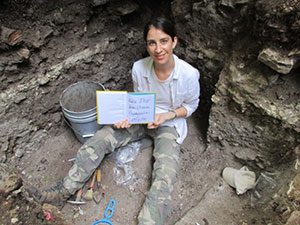Assistant professor of anthropology receives grant to continue research projects
Katie Miller Wolf has received a Women’s Philanthropy Leadership Council grant from the Indiana University Foundation that is allowing her to study the lives and deaths of prehistoric populations in three countries of Central America.
The $5,940 was awarded for the current academic year by the Women’s Philanthropy Leadership Council following a presentation this summer by Miller Wolf, assistant professor of anthropology at IU East.
Her research effort, titled “Learning from the Past: Life and Death in Prehistory,” also is being funded with $7,000 from the 2017 Indiana University East Summer Faculty Fellowship.
The bioarchaeologist is testing human skeletal remains at sites in Belize, Guatemala and Honduras. Miller Wolf said she has been working in those countries for about 15 years.
“Your skeleton tells a story, we can hear it. We can say what happened even a thousand years ago,” she said about her fascination with the field of study.
Bioarchaeologists are both archaeologists and physical anthropologists. We conduct excavations but also work in the lab to carefully analyze human remains. While some archaeologists specialize in the study of ceramics, for example, bioarchaeologists specialize in human remains, she explains.
Her fascination has her sharing in the projects titled “Religious Conversion in Tayasal, Guatemala”; “British Colonialism and Slavery in Belize City, Belize”; and “Migration and Identity in Prehistoric Honduras (El Cajon, Honduras).”
She is helping to determine through DNA samples how Maya people died in the last place that Spaniards conquered in Guatemala.
The Maya were basically given an ominous choice, Miller Wolf said, to convert to their conquerors’ religious beliefs or die. Many did die from starvation related diseases such as scurvy, which is caused by a lack of vitamin C (fruits and vegetables in the diet).
Miller Wolf works often in Belize at the Maya Research Program, an archaeological project and site where she runs a bioarchaeology field school each summer. While working there, Miller Wolf was contacted by St. John’s College to help study a dozen skulls were found in an attic there. The quest to find how they died and where they were from originally (indigenous, African slaves, indentured servants from Europe) has led to an evolving project involving the school’s historian Carlo Quiroz and Hannah Plumer, Ph.D., Miller Wolf’s friend and fellow bioarchaeologist.
Their efforts helped in recovering remains from 75 others dating back into the 1600s. Many of them had apparently died after being quarantined on an island because of diseases.
The work to unravel the mystery has the blessing of the leader of St. John’s. “They gave us full access. Belize is interested in this, too,” Miller Wolf says. “The least we can do is give a voice to those bones.”
The project is analyzing 20 random samples on those bones and teeth to see where the people were born. Two carbon date tests (more expensive) will help to identify time periods.
Miller Wolf’s third project includes studying migration and kinship in Honduras in the classic Maya period from about 600-900 AD.
The grant monies will allow her to return to Central America next summer.
She often can bring her experiences back into the classroom at IU East. She also works with students in Richmond through Girls Inc. and the Third Grade Academy. She also talks to high school girls about cultures and careers in science, and the science courses taught by Heidi Hisrich.
Working with students from college to elementary school is natural for Miller Wolf. She knew she wanted to work in archaeology by the time she was 8 years old. “Indiana Jones looked like the most amazing thing,” she jokes.
Her parents encouraged her by giving her books on archaeology.
Miller Wolf started learning Spanish in the seventh grade after becoming fascinated with the Aztec and Maya cultures.
She went to Belize for research during her senior year at IU Bloomington and “branched out” through graduate studies at Arizona State University.
The IU Women’s Philanthropy Leadership Council was convened by the Indiana University Foundation Board of Directors in 2010. Its mission is to lead fundraising and engagement efforts that inspire women to give of their time, talent and resources to Indiana University, and to develop women leaders in philanthropy.
Founded in 1936, the Indiana University Foundation maximizes private support for Indiana University by fostering lifelong relationships with key stakeholders and providing advancement leadership and fundraising services for campuses and units across the university.



